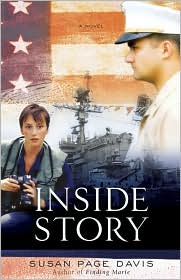|
We
don’t like to be scared. Or do we?
If that spurt of adrenaline, the
chattering pulse, the sudden intake of breath is caused by what lies on
the printed page, we love it.
I write romantic suspense
novels. My three-book American Heroes series from Harvest House carries
the reader off to adventure with naval officers and the men and women
who love them. In the latest volume, journalist Claudia Gillette gets
into situations I couldn’t get myself into in real life if I wanted to.
Ultimately, she barges into a top secret mission and royally messes it
up. Poor Lieutenant Bill White has to salvage what he can of the op and
also keep Claudia from getting killed.
One of my favorite ways to up
the ante for the reader is to put a person who just doesn’t “get it” in
danger. Here’s an excerpt from Inside Story, when
Bill rescues Claudia. She’s an intelligent woman but doesn’t understand
the magnitude of their danger.
“They’re
targeting the boat,” Stu said. They watched helplessly.
A small explosion poofed, and orange flames rose from the stern of the
boat.
“Direct hit,” Heidi whispered.
Suddenly the plane turned and sped toward the island.
“Take cover!” Dryden pushed Heidi ahead of him and rushed back
to help Stu shove the radio equipment toward the overhanging rock face.
Bill ran through the brush, grabbed Claudia’s wrist, and yanked
her out of the small clearing. He shoved her into the thickest
underbrush
and threw himself on top of her.
“Keep your head down.” He smashed his face into her back. She
had no helmet, but at least his body armor could protect her, to some
extent.
“I can’t breathe!”
He barely heard her protest as the plane roared directly over
them. As the sound of the engine grew a little less unbearable, Claudia
wiggled, and he raised himself on his elbows to give her more mobility.
“That was close.” She tried to shove him away.
“It’s not over,” Bill said grimly.
“What do you mean?” The engine noise grew louder.
“They went straight for the boat, then made a pass looking for
us. Come on, move further into the woods.”
“What—”
|
Too late.
Sporadic gunfire erupted as the plane swooped over
their position again. Bill pushed her down and hid his face again. A
couple
of the men on the ground opened fire on the plane as it skimmed the
treetops. A shell exploded only yards away. Bill jumped and held
Claudia
down in spite of her wriggling. Another hit farther away, then another.
There
comes a point in each suspense book when you wonder if the main
characters will be able to get out of the fix they’re in. Of course,
you’re pretty sure they’ll come through it alive and for the most part
unscathed. And the bad guys will get their comeuppance. But for a few
minutes, we ignore that knowledge and let ourselves be scared so that
we enjoy the tension and excitement of the story.
Most stories of this nature have
some characters to whom, unfortunately, we must say good-bye. As Terry
Brooks once put it, “Some are only there for cannon fodder.” But others
are characters we come to know and, yes, even respect and love, like
Stu in Inside Story. It took a lot of nerve to do
what I did to Stu. I still feel remorse.
I don’t like to kill characters.
But it comes with the territory. As filmmaker George Lucas puts it,
 “The trouble with cliff hangers is you
get somebody into something, you
sort have to get them out in a plausible way.” Sometimes, especially in
suspense books, that way is painful. “The trouble with cliff hangers is you
get somebody into something, you
sort have to get them out in a plausible way.” Sometimes, especially in
suspense books, that way is painful.
(In case you’re wondering,
Claudia learns fast. After the above episode, she grows to the point
where she is able to rescue someone more vulnerable than she is.)
I also write historical romance,
contemporary romance, cozy mysteries, and I even have a couple of
children’s novels. I have to plead guilty as charged—no matter what
genre the story is, if you pick up one of my novels, you’ll probably
find at least a smattering of suspense between the covers.
It doesn’t have to be gasping,
heart-thumping terror on every page. Sometimes it’s just a little
mystery—who’s messing with the family business’s books? Sometimes it’s
out-and-out danger and intrigue—did the next-door neighbor really kill
his wife? After all, suspense is the form of conflict that best keeps
us turning the pages. I can’t seem to write a story without it, and I’m
not sure I want to. Suspense, danger, that quickening of the pulse as
you read . . . the ultimate in whisking us out of our boring lives.
To writers, my advice is: Go
ahead. Make your characters take more risks. And to readers: Enjoy
every hair-raising second.
|








